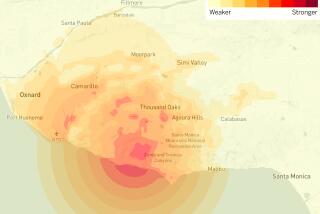5.0 Quake Jars Memories; Little Damage Found
The strongest series of quakes in nearly two years struck near Simi Valley early Saturday, rattling nerves across Southern California and surprising scientists who believed the worst of the Northridge aftershocks had passed.
Eerily reminiscent of the devastating quake that rocked the region three years ago, the magnitude 5.0 aftershock hit at 3:37 a.m., but left little real damage and no reported injuries. Nor did the 4.0 shock that came three minutes later, followed by 26 smaller quakes over the next four hours.
But the psychological impact from the spasm of quakes hit hard among Ventura County and San Fernando Valley residents once again shaken from sleep.
“It was a very heavy, heavy shaking,” said Simi Valley resident David LaTourette, whose mobile home sustained $20,000 in damage in the 1994 quake.
“It started out slowly, then all of a sudden it got stronger, and I just thought, ‘Oh God, not another one of these things.’ You never get used to it.”
“It shook like hell,” said Tom Glancy, whose Thousand Oaks house sustained $180,000 in damage during the Northridge quake.
“My wife’s first reaction was ‘Not again,’ ” he said. “Not so much for the rattle and roll, but for the house. . . . You can spend a lot of time, emotional energy and money fixing it, and it can happen again.”
Northridge resident Carol Lackey knew the quake was not as severe when she glanced at her bedside alarm clock, whose digital numbers were still blinking.
“I could see it, so I knew that we at least had power,” she said. “The pitch black in ’94 was the scary thing.”
Unnerved by the moderate temblor, Van Nuys resident Manisha Hunter huddled in bed with her two daughters, Jamiesha, 5, and Danisha, 4, but was unable to get back to sleep.
“The kids got up and came running into my bed,” Hunter said. “It scared me a little because I thought that it was going to be another Northridge earthquake.”
Hunter rubbed the girls heads until they fell asleep, then carefully took all the belongings off her shelves.
“I went out and moved my car out of the garage just in case,” she added. “I am pretty much ready--ready for the big one.”
The intensity of Saturday’s quakes surprised seismologists, who believed the last of the strong Northridge aftershocks had come in 1995.
*
The magnitude 6.7 quake struck at 4:31 a.m. on Jan. 17, 1994, leaving 57 dead and causing $27 billion in damage, much of it in the San Fernando Valley, Simi Valley and Fillmore. Scientists have counted as many as 13,750 aftershocks since then.
Slightly chastened Jim Mori, scientist in charge of the U.S. Geological Survey’s Pasadena office, said Saturday: “These predictions we make have to be taken with uncertainty.”
As recently as January, Lucy Jones of the Geological Survey, and Caltech seismologist Kate Hutton had said in a written report that over the next year, four magnitude 3.0 or larger jolts should be expected.
Instead, on Saturday, there were eight such quakes in one day, including six magnitude 3.0s, one 4.0 and one 5.0.
The quakes hit seven miles northeast of Simi Valley, on the Los Angeles-Ventura county line, about two miles south of California 126.
Like such historic bigger quakes as Northridge, San Fernando and Tehachapi, Saturday’s shocks struck while most people were asleep. They fell within the northern end of the Northridge rupture zone, and were felt from Santa Barbara to Riverside.
Law enforcement officials in Los Angeles and Ventura counties said they received no reports of damage, but answered numerous calls from anxious residents wanting to know about the strength of the initial quake.
“All that adrenaline and all those fears come back for those people who went through it,” said Annie Ironside, a dispatcher for the Ventura County Fire Department.
In the San Fernando Valley, patrol cars began searching for signs of damage, checking local hospitals, freeway underpasses and the Civic Center in Van Nuys for signs of trouble. Back at the police stations, desk officers fielded calls from concerned residents seeking reassurance.
“It got everyone’s attention, that’s for sure,” said Los Angeles Police Lt. Jerry Nicholson, a watch commander at the Devonshire Division. “There was a whole bunch of alarms going off, but that always happens.”
Simi Valley City Manager Mike Sedell spent much of the morning huddling with public safety officials to assess any potential damage. But Sedell said that the city came through the wave of aftershocks without so much as a power outage.
*
“Certainly, the shaker woke us all up,” he said. “But there was no reported damage of any kind. So the feeling here is one of relief.”
Mayor Greg Stratton joked that he has become so accustomed to earthquakes and aftershocks that he can pretty well measure their strength without a Richter Scale. “We can calibrate them pretty quickly now,” he said. “It’s like, oh, that’s a 5.0.”
Asked if the earthquake would help the city get federal money to replace its quake-damaged police station, Stratton said, “maybe this will shake them up in Washington.”
At Magic Mountain, just across the Los Angeles County line from the quake’s epicenter, mechanics set out at 4 a.m. to test all the rides and found no signs of damage.
“The forces generated each time a roller coaster runs exceed that of most earthquakes,” said Palmer Moody, public relations assistant manager.
The quakes came toward the end of the state’s annual Earthquake Preparedness Month, when government agencies hold emergency training for personnel and schools conduct earthquake drills.
At the Simi Country mobile home park, which was badly damaged in the Northridge quake, residents were unnerved by the most recent series of shakes.
“I just thought, ‘Here we go again,’ ” said Betty Healy, who immediately ran out of her trailer after the initial early morning temblor.
As bad as it felt, though, Healy said Saturday’s aftershocks were nothing compared to the 1994 earthquake, which split her trailer in two, leaving $24,000 in damage.
“This park looked like the blitz,” Healy said, recalling the early quake.
*
In Fillmore, where the Northridge quake damaged or destroyed more than 400 homes and businesses, Saturday morning’s aftershocks rattled some nerves.
“You can’t help but look back on it and hope it’s not happening all over again,” said 60-year-old Gerrie Garner, a Fillmore resident for more than 50 years. “With all we’ve been through here, you can understand that when things start shaking we get a little scared.”
Garner owns a hardware store on Fillmore’s Main Street and spent a year and more than $200,000 to get her business back up and running.
“I think a lot of us would agree that Fillmore’s a better place than it was before the big earthquake,” she said. “It looks a lot better.”
Mayor Roger Campbell, whose house was destroyed during the Northridge quake, said his family hasn’t felt a single aftershock rattle the walls of their new home--until Saturday.
The facts that the house didn’t crack and the town wasn’t damaged only reinforced their sense of recovery, Campbell said.
“After you have gone through something like we had three years ago, it doesn’t affect you as much,” he said. “It is a source of pride for the people of Fillmore that we have come back so strongly.”
In nearby Piru, the closest town to Saturday’s epicenter, residents boasted that the only thing the quake cost them was a few minutes of sleep.
“To be perfectly honest I’d rather go through an earthquake than a tornado,” said Donna Venegas, a cashier at Elva’s Central Market. “I’d rather rock and roll than swirl around.”
Times staff writers Kenneth Reich, James Ricci and Julie Tamaki and correspondents Chris Chi, Karima A. Haynes and Coll Metcalfe contributed to this story.
* RATTLED NERVES
Tremors bring out 3-year-old nightmares for many. A14
More to Read
Start your day right
Sign up for Essential California for news, features and recommendations from the L.A. Times and beyond in your inbox six days a week.
You may occasionally receive promotional content from the Los Angeles Times.






